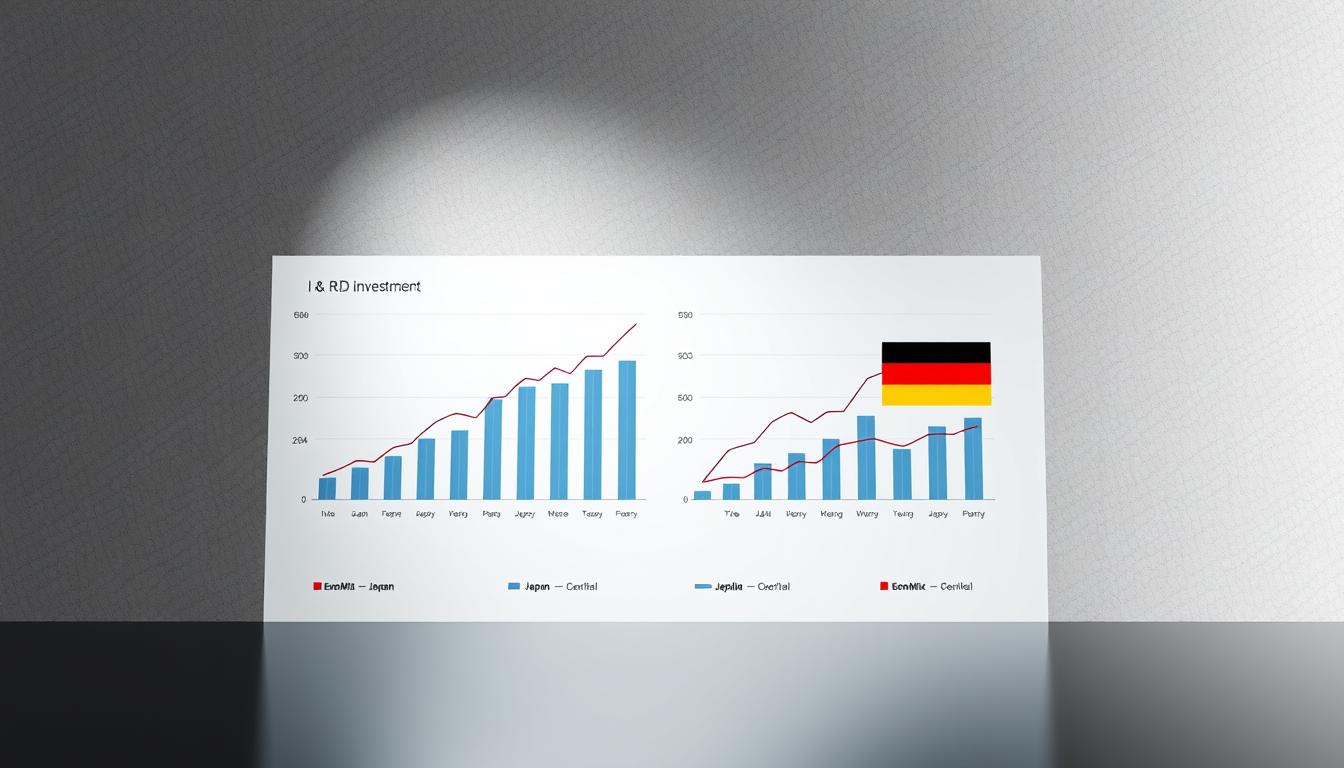As the global economy continues to evolve, the question on everyone’s mind is: which nation is truly leading the charge in industrial innovation? Two manufacturing powerhouses, Japan and Germany, have long been at the forefront of technological advancements and industrial development.
Innovation is the driving force behind a nation’s economic growth and competitiveness in the world market. According to the Global Innovation Index 2024, both Japan and Germany rank highly, but their approaches to innovation differ significantly.
The comparison between these two economic giants is not just about their current standings but also about their strategies for future growth and development. Are they focusing on R&D investment, manufacturing excellence, or digital transformation?
Key Takeaways
- Comparison of Japan and Germany’s innovation metrics
- Analysis of R&D investment and manufacturing excellence
- Digital transformation initiatives in both countries
- Sector-specific innovation leadership
- Approaches to talent development and government policies
The Global Innovation Landscape
The Global Innovation Index (GII) provides a comprehensive framework for evaluating national innovation performance across various economies. It considers both innovation inputs, such as institutions, human capital, and infrastructure, and outputs, including knowledge creation and creative outputs.
The GII rankings for 2024, derived mainly from 2022 and 2023 data points, show Switzerland maintaining its top position for the 14th consecutive year, leading in both Knowledge and technology outputs and Creative outputs. Sweden and the United States follow closely, holding their second and third positions, respectively.
Understanding Innovation Metrics and Rankings
Innovation metrics extend beyond patent counts to include R&D expenditure as a percentage of GDP, researcher density, university-industry collaboration, and commercialization success rates. These metrics provide a nuanced understanding of a country’s innovation position in the world.
Japan currently ranks 13th in the GII, while Germany is among the top 10 global innovators. Both countries face increasing competition from rapidly advancing economies like China, South Korea, and Singapore, which are investing heavily in innovation capabilities to drive growth in their respective markets.
Understanding these metrics and rankings is crucial for evaluating the relative innovation performance of countries like Japan and Germany within the broader global landscape of technological and industrial advancement. It highlights the importance of continuous innovation in maintaining a competitive edge in the global market, with about 80 percent of the data pointing towards the significance of R&D expenditure and innovation outputs.
Japan and Germany: Who is ahead in industrial innovation?
Industrial innovation is a key domain where Japan and Germany are vying for supremacy. Both countries have a rich history of industrial development and have been at the forefront of technological advancements.
Historical Context of Industrial Development
Japan and Germany share similar post-WWII industrial development trajectories, rebuilding their economies through manufacturing excellence and export-oriented growth strategies. Germany’s “Mittelstand” of specialized medium-sized manufacturers parallels Japan’s keiretsu industrial groups, though with different ownership structures and financing approaches.
- Both countries have a strong focus on innovation and R&D.
- They have different approaches to financing and industrial organization.
Current Innovation Rankings and Performance Indicators
Current innovation rankings show Germany typically outperforming Japan in global innovation indices, with Germany consistently placing in the top 10 while Japan has remained at 13th since 2021. Japan excels in specific metrics like R&D expenditure (over 3% of GDP) and patent generation in fields like technology, while Germany leads in manufacturing process innovation and industrial automation.
- Performance indicators reveal Japan struggling with productivity growth despite high R&D investment.
- Germany demonstrates stronger commercialization of research and university-industry collaboration.
Both countries face challenges from aging populations and competition from emerging innovation powerhouses, though they respond with different policy approaches and industrial strategies. The position of Japan and Germany in the global market is influenced by their ability to adapt to these challenges.
R&D Investment Comparison
R&D investment is a critical factor in the industrial innovation landscape, with Japan and Germany adopting distinct strategies to drive growth. Both countries have demonstrated a strong commitment to R&D, but their approaches differ in terms of funding sources and allocation.
Japan’s R&D Expenditure Patterns
Japan maintains one of the world’s highest R&D expenditure levels, at over 3% of GDP, with significant corporate investment particularly in the automotive, electronics, and materials science sectors. Japanese companies have been at the forefront of R&D, focusing on applied research and incremental improvements to drive innovation and development. However, despite high R&D spending, Japan has struggled to translate this investment into tangible results over the past two decades.
According to the World Bank, in 2000, Japanese companies and research institutions accounted for more than 30% of the patents awarded every year. This share has now fallen to 10%. The heavy reliance on corporate funding, with relatively less government contribution, characterizes Japan’s R&D investment landscape.

Germany’s Approach to R&D Funding
Germany’s R&D investment reached approximately 3.1% of GDP, showcasing a more balanced distribution between corporate, government, and academic research funding. Institutions like the Fraunhofer Society play a crucial role in collaborative funding models that bring together industry, government, and academic institutions, particularly in sectors like automotive, industrial machinery, and renewable energy technologies.
| Country | R&D Expenditure (% of GDP) | Main Funding Sources |
|---|---|---|
| Japan | Over 3% | Corporate |
| Germany | Approximately 3.1% | Balanced (Corporate, Government, Academic) |
While both countries invest heavily in R&D, Germany has demonstrated greater efficiency in translating research investment into commercial success and productivity growth, suggesting differences in R&D allocation and management approaches.
Manufacturing Excellence and Quality Standards
Manufacturing excellence is a hallmark of both Japanese and German industries, achieved through rigorous quality control and innovative production systems. This excellence is not merely a result of technology, but also of deeply ingrained philosophies and cultures that prioritize quality and precision.
Japan’s Manufacturing Philosophy and Strengths
Japan’s manufacturing excellence is built on philosophies like kaizen (continuous improvement) and lean production systems, pioneered by companies like Toyota. Japanese manufacturers excel in high-precision components and electronics miniaturization, requiring meticulous attention to detail and quality consistency. The focus on defect elimination and rigorous quality control has enabled Japanese firms to sustain competitive advantage over time.

German Engineering and Precision Manufacturing
Germany’s manufacturing strength stems from its Industrie4.0 approach, combining traditional engineering precision with advanced automation, robotics, and data-driven production systems. German engineering is characterized by its focus on durability, precision, and high-value specialized machinery, with companies like Siemens and Bosch leading in industrial equipment and automation technologies. While Japan excels in production process efficiency, Germany leads in engineering innovation and the integration of digital technologies into manufacturing systems.
The contrast between Japan’s and Germany’s approaches highlights the diverse paths to achieving manufacturing excellence and high quality standards. Both countries demonstrate that a commitment to innovation, quality, and precision is crucial for industry leadership and superior performance.
Digital Transformation Progress
Digital transformation has emerged as a key driver of industrial innovation, with Japan and Germany adopting distinct approaches. Both countries are leveraging digital technologies to enhance their industrial capabilities, but their strategies and progress differ in several key areas.
Japan’s Society5.0 Vision and Implementation
Japan’s Society5.0 vision represents an ambitious plan to create a human-centered society that balances economic advancement with social challenges through the integration of cyberspace and physical space. As stated by Prime Minister Shinzo Abe’s “Abenomics2.0” program, the focus is on “applying the innovations created through the Fourth Industrial Revolution across all industries and all aspects of daily life.” This comprehensive approach aims to boost productivity, drive innovation and trade, and energize corporate activities.
Despite this forward-looking vision, Japan faces implementation challenges, including digital talent shortages and slower adoption of cloud services and AI technologies compared to global leaders. According to recent data, Japan underperforms in areas such as technological talent, business agility, and IT integration.

Germany’s Industry4.0 Initiative
Germany’s Industry4.0 initiative focuses specifically on manufacturing digitalization through smart factories, cyber-physical systems, and the industrial internet of things (IIoT). German manufacturers have made significant progress in implementing digital twins, predictive maintenance systems, and automated production lines, supported by strong technical education and specialized research institutes. This targeted approach has enabled Germany to maintain its competitive edge in industrial manufacturing.
A comparison of the two nations reveals that Germany is generally ahead in industrial digitalization implementation, while Japan’s vision is broader but faces more significant cultural and organizational barriers to digital transformation. As both countries continue to evolve their digital strategies, their progress will be closely watched by industry observers worldwide.
Innovation Output Metrics
Innovation output metrics provide valuable insights into the R&D performance of Japan and Germany. These metrics are crucial for understanding how effectively both countries translate their research investments into tangible innovations.
Patent Generation and Intellectual Property
Japan has historically been a leader in patent generation, with its companies and research institutions accounting for more than 30% of global patents in 2000. However, this figure has declined to around 10% today. Despite this decline, Japan retains its leadership in specific sectors such as semiconductor technology. In contrast, Japan has been overtaken by other countries, notably China, in areas like audiovisual technology, computing, and telecommunications.
The quality of patents is another important aspect. While Japanese companies excel in patent quantity, they face challenges in translating intellectual property into commercial success. On the other hand, Germany generates fewer patents but demonstrates higher efficiency in commercializing research, thanks to stronger university-industry collaboration and technology transfer mechanisms.
Commercialization of Research
The commercialization of research is a critical innovation output metric. Germany’s Fraunhofer model provides a direct pathway from research to market application, enhancing the commercialization of R&D outputs. In contrast, Japan’s more corporate-centric innovation model sometimes struggles to achieve the same level of commercial success.
| Country | Patent Generation | Commercialization Efficiency |
|---|---|---|
| Japan | High quantity, declining share | Lower efficiency |
| Germany | Fewer patents, higher quality | Higher efficiency |
The difference in commercialization efficiency between Japan and Germany highlights the importance of having effective technology transfer mechanisms in place. Germany’s approach emphasizes the quality of patents over quantity, resulting in higher citation rates and commercial application rates.
Sector-Specific Innovation Leadership
Sector-specific innovation leadership reveals unique competitive advantages in Japan and Germany, with each country excelling in different areas.
Automotive Innovation Comparison
In the automotive sector, Germany leads in premium vehicle technology, autonomous driving systems, and electric vehicle architecture, primarily through companies like Volkswagen Group, BMW, and Mercedes-Benz. These companies have made significant investments in R&D to stay ahead in the global market. In contrast, Japanese automakers such as Toyota and Honda excel in hybrid technology, manufacturing efficiency, and reliability engineering, although they have been slower to fully adopt electric vehicle technology.
Electronics and Technology Sectors
The electronics sector shows Japan maintaining its strength in components, materials, and precision equipment through companies like Sony, Canon, and Nikon. However, Japan struggles to maintain leadership in consumer electronics and computing. Germany’s technology sector, on the other hand, is more focused on industrial applications, enterprise software (notably SAP), and specialized electronic systems rather than consumer electronics.
- Japan leads in industrial robot production and deployment.
- Germany excels in complete industrial systems and factory automation solutions.
Industrial Machinery and Robotics
In industrial machinery and robotics, Japan leads through companies like FANUC and Yaskawa, with exceptional strength in precision components. Germany, through companies like Siemens, KUKA (now Chinese-owned), and Bosch, excels in complete industrial systems, specialized manufacturing equipment, and factory automation solutions, with a greater emphasis on integrated solutions. For more insights on how these countries are positioning themselves in the global economy, visit Economix Plus.
Both countries demonstrate strong innovation capabilities across various sectors, driven by significant investments in R&D and a focus on manufacturing excellence. The competitive landscape highlights the importance of technology and industry collaboration in driving innovation forward.
Digital Services and Software Development
Japan and Germany are two major economies with distinct approaches to digital services and software development. While both countries have made significant strides in the digital realm, their strategies and areas of focus differ.
Japan’s Digital Services Trade Balance
Japan’s digital services exports have grown impressively at 43% annually from 2010 to 2023, outpacing import growth. Despite this, Japan’s trade deficit in digital services has grown from 0.17% of GDP to 0.27% between 2014 and 2023. The country’s digital services exports are particularly strong in creative industries, gaming, and specialized business services.
Notably, Japan’s imports of digital services in 2023 were still twice as large as its exports. However, the growth in exports indicates a positive trend, with Japan expanding its digital services market, especially to the United States, European Union, Singapore, and China.
Germany’s Software Industry and Digital Services
Germany’s software industry is anchored by global enterprise software leader SAP, with a strong position in business software, industrial applications, and specialized technical solutions. German digital services show greater integration with manufacturing through industrial software, digital twins, and factory automation systems, creating a more balanced digital services trade profile.
The comparison between Japan and Germany reveals that while Germany has an advantage in industrial software and enterprise solutions, Japan shows growing strength in creative digital services, gaming, and anime-related digital exports. This highlights the diverse approaches both countries are taking in the digital economy.
Government Policies Supporting Innovation
Government policies play a crucial role in fostering innovation, with both Japan and Germany implementing unique strategies to drive technological advancements. Effective policies can significantly influence a country’s innovation capacity by providing necessary support for research and development (R&D), encouraging entrepreneurship, and creating an environment conducive to technological progress.
Japan’s Innovation Policy Framework
Japan’s approach to supporting innovation is multifaceted, focusing on initiatives like Society5.0 and the Moonshot Research and Development Program. These programs aim to drive technological innovation and apply it across various industries. The Japanese government also offers R&D tax incentives and direct funding for strategic technologies to encourage corporate innovation.
- Emphasis on Society5.0 to integrate technology into daily life and industries.
- Moonshot Research and Development Program for ambitious technological goals.
- R&D tax incentives to encourage corporate investment in innovation.
Germany’s High-Tech Strategy
Germany’s High-Tech Strategy2025 provides a comprehensive framework for innovation policy, focusing on key technologies and societal challenges. The strategy involves coordination across government, industry, and academia to drive innovation. The German government supports R&D through direct funding and tax incentives, and institutions like the Fraunhofer Society play a crucial role in advancing technological development.
| Aspect | Japan’s Approach | Germany’s Approach |
|---|---|---|
| Innovation Framework | Society5.0, Moonshot Program | High-Tech Strategy2025 |
| R&D Support | Tax incentives, direct funding | Direct funding, tax incentives, institutional support |
| Implementation | Centralized policy approach | Federalized approach with regional specialization |
Both countries demonstrate strong commitment to innovation through government policies, though their approaches differ in implementation and focus areas.
Talent Development and Workforce Challenges
The ability to attract, develop, and retain talent is a significant determinant in the innovation capabilities of Japan and Germany. Both countries face unique challenges in this regard, impacting their industrial innovation.
Aging Workforce and Talent Acquisition Strategies
Japan is grappling with a severe demographic challenge, with its working-age population projected to decline from 75 million in 2018 to 69 million by 2030. This decline creates critical shortages in engineering and R&D talent. Japanese companies struggle with talent acquisition, with only 28% of surveyed R&D executives believing their firms could attract and retain top engineering talent. To address these challenges, Japan is exploring strategies such as increased automation, gradual immigration reform, and efforts to improve workplace flexibility.
Technical Education and Talent Retention
Germany, on the other hand, benefits from its dual education system, which combines practical vocational training with theoretical education. This produces highly skilled technical workers who form the backbone of its manufacturing innovation ecosystem. German companies also benefit from stronger university-industry collaboration and more flexible immigration policies for skilled workers. The comparison reveals that Germany has a significant advantage in talent development and retention.
| Country | Talent Acquisition Strategies | Education System |
|---|---|---|
| Japan | Automation, Immigration Reform, Workplace Flexibility | Theoretical Focus |
| Germany | University-Industry Collaboration, Flexible Immigration | Dual Education System |
The talent development comparison highlights Germany’s ability to develop, attract, and retain technical talent as a significant advantage in the innovation race.
Collaborative Innovation Ecosystems
The era of solo innovation is fading, making way for collaborative ecosystems that drive industrial progress. In today’s competitive landscape, companies are increasingly relying on collaborative efforts to stay ahead. This shift is particularly evident in Japan and Germany, two nations at the forefront of industrial innovation.
Japan’s Industry-Academia Partnerships
Historically, Japan’s industry-academia partnerships have been weaker compared to other advanced economies. Companies preferred to conduct R&D in-house rather than collaborate with universities or research institutions. However, recent reforms have aimed to strengthen these connections through initiatives like the Cross-ministerial Strategic Innovation Promotion Program (SIP) and increased funding for collaborative research centers. Despite these efforts, Japanese innovation ecosystems still face challenges such as rigid organizational structures and limited researcher mobility between academia and industry.
Germany’s Fraunhofer Model and Innovation Networks
Germany’s Fraunhofer model is a successful framework for applied research and technology transfer, with 76 institutes working directly with firms on commercializing R&D. The German innovation ecosystem features strong regional clusters, extensive networks connecting SMEs with research institutions, and fluid movement of researchers between academia and industry. This collaborative approach has given Germany a significant edge in industrial development and R&D, fostering a culture of collaboration that drives progress.
Export Competitiveness and Global Market Share
Japan and Germany are vying for dominance in the global export market, with each country showcasing its unique strengths. The competitiveness of their exports is crucial to their economy and reflects their industrial innovation capabilities.
Japan’s Export Performance in High-Tech Industries
Japan’s export performance in high-tech industries presents a mixed picture. While the country has seen a decline in its global market share in consumer electronics and computing hardware, it maintains strength in areas such as automotive, semiconductor manufacturing equipment, and specialized components. Japanese exports are increasingly focused on high-value components and materials rather than finished consumer products. Companies like Tokyo Electron, Murata, and Nidec are providing critical technologies for global supply chains. Japan continues to hold strong export positions in precision instruments, robotics, and specialized machinery, although it faces increasing competition from South Korea, Taiwan, and China in several sectors.
Germany’s Export-Driven Innovation Model
Germany’s export-driven innovation model is centered on specialized manufacturing equipment, premium automobiles, chemicals, and industrial machinery. Exports account for approximately 47% of Germany’s GDP, underscoring the significance of trade in its economy. German manufacturers maintain global leadership in numerous industrial niches through the “hidden champions” approach – medium-sized companies that dominate specific global market segments through continuous innovation. The comparison between Japan and Germany reveals that Germany has been more successful in adapting to global market shifts, maintaining stronger export market shares across its industrial base.
The competitiveness of Germany’s exports is enhanced by its focus on high-value products and its ability to innovate continuously. This approach has allowed German companies to stay ahead in the global trade landscape.
Challenges and Weaknesses
Japan and Germany, while being at the forefront of industrial innovation, encounter several bottlenecks that affect their R&D performance. Despite their technological advancements, both countries face significant challenges in their innovation ecosystems.
Japan’s Innovation Bottlenecks
Japanese firms struggle with corporate cultures that prioritize incremental improvements over disruptive innovation. According to Bank of Japan research, this focus results in lower productivity growth from R&D spending compared to their American counterparts.
- Rigid organizational structures and risk aversion hinder knowledge flow and creative problem-solving.
- Limited mobility of researchers between companies and institutions restricts collaborative innovation.
- Slow digital transformation and declining R&D efficiency are additional challenges.
Attracting global talent is also a significant issue, with only 28% of surveyed R&D executives believing their companies could attract top engineering talent.
Germany’s Innovation Challenges
Germany faces its own set of innovation challenges, including high energy costs that affect manufacturing competitiveness and digital infrastructure gaps. Bureaucratic hurdles for startups and new business models also pose significant obstacles.
| Challenge | Description | Impact |
|---|---|---|
| Risk Aversion | Financing disruptive innovations | Limited venture capital |
| Demographic Pressures | Aging workforce issues | Impact on R&D productivity |
| Digital Infrastructure | Gaps in digital infrastructure | Hinders digital transformation |
Both Japan and Germany must balance their traditional industrial strengths with the need to develop capabilities in emerging technologies like artificial intelligence, quantum computing, and biotechnology.
Future Outlook: Emerging Technologies and Trends
Emerging technologies and trends are expected to drive the next wave of industrial innovation, with Japan and Germany leading the charge. Both countries have been at the forefront of technological advancements, and their future strategies will be crucial in shaping the global industrial landscape.
Japan’s Strategic Focus Areas
Japan is concentrating on several key areas to drive future innovation. Robotics and automation are being prioritized to address labor shortages, while companies like Fujitsu are leading research in quantum computing. Additionally, Japan is investing in regenerative medicine and healthcare technologies to cater to its aging population.
The Japanese government’s Moonshot Research and Development Program has identified six priority areas: aging society, carbon neutrality, AI and robotics, quantum technology, disaster prevention, and space exploration. Japanese companies are also leveraging their expertise in materials science and manufacturing to invest in sustainability technologies, particularly in energy efficiency, hydrogen energy systems, and battery technology.
Germany’s Innovation Priorities
Germany, on the other hand, is focusing on maintaining its leadership in Industry 4.0 technologies, developing hydrogen and renewable energy systems, and advancing quantum technologies. Germany is also strengthening its position in medical technology and biotechnology.
The German High-Tech Strategy 2025 emphasizes key innovation fields such as digital transformation, sustainable economy and energy, innovative workplace, healthy living, intelligent mobility, and civil security. While both countries are investing in similar emerging technology areas, Japan is focusing more on robotics and technologies addressing demographic challenges, whereas Germany is prioritizing industrial systems, sustainability technologies, and maintaining manufacturing leadership.
Conclusion: The Innovation Race Continues
The comparison between Japan and Germany’s innovation strategies reveals valuable insights into their respective strengths and challenges. Currently, Germany holds an edge in several key metrics, including innovation efficiency, collaborative ecosystems, and maintaining export market share. Germany’s more developed collaborative innovation ecosystem, particularly the Fraunhofer model of applied research and technology transfer, provides a significant advantage in translating R&D investment into commercial success.
Japan, on the other hand, maintains significant strengths in specific domains like robotics, materials science, and precision manufacturing. However, it faces more substantial challenges in digital transformation, talent development, and research commercialization. Both countries must address similar challenges, including aging populations and competition from emerging innovation powerhouses like China and South Korea.
For businesses and policymakers, this comparison offers valuable lessons about the importance of collaborative innovation ecosystems and efficient R&D investment. The future innovation landscape will likely see continued German leadership in industrial systems and manufacturing equipment, while Japan may find renewed strength in robotics and healthcare technologies. To stay ahead, both countries must leverage their unique industrial and cultural strengths to create distinctive value in the global marketplace. For more insights on innovation leaders, visit Relecura’s analysis on the frontrunners in the innovation.
The ultimate winner in this innovation race will be the country that most effectively addresses its structural challenges while creating value through innovation and R&D. As both Japan and Germany continue to evolve their innovation strategies, their exports and services will play a crucial role in determining their global market share and overall performance.












